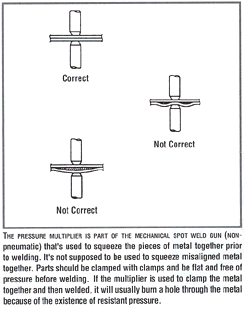Ever seen a Squeeze-Type Resistance Spot Welder in action? Though you might be reluctant to change your ways, once you’ve examined the pros and cons of STRSW, you’ll find this welding method produces a factory-like repair in less time.

Though many of us in the collision repair industry consider spot welding a more recent welding repair method, Squeeze Type Resistance Spot Welding (STRSW) has been around for years. How many years? Well, I’m not sure, but I do have a collision repair manual copyrighted in 1939 with a full chapter devoted to spot welding. The machines are both single- and three-phase 220-volt welders and are also capable of arc welding. So I’m going to estimate that spot welders have been used in the collision repair aftermarket for some 60 to 70 years, with varying degrees of popularity.
Despite it’s long history, “resistance welding” is aptly named – because many technicians still continue to resist using it. Why? For many reasons, I believe. It’s new (they think), and it makes them uncomfortable. Change forces people out of their comfort zone because they aren’t sure of exactly how – in this case – the technology works.
Granted, a spot welder has many settings, and a full understanding of each control setting is essential for success. Spot welding guns are also heavier and more awkward to use than a MIG welder. You also need access to both sides of the metal, and the weld to be performed must be an overlap weld.
I, however, am an advocate of STRSW, and its considerable advantages far outweigh any perceived – or real – disadvantages. In fact, let’s examine the “so called” disadvantages. Then we’ll look at some common mistakes, along with tips for properly performing STRSW.
Problem No. 1:
It’s new and different.
OK, but so was the MIG welder, frame bench and HVLP spray gun. But these advances made our jobs easier and healthier. And so does resistance spot welding. Is there anyone out there who really likes plug welding the wheel opening of a quarter panel and all the attendant finish grinding that’s necessary to clean up the wheel opening? Those hot sparks rolling down your neck and cooling off while making sizzling sounds around your belt-line give off an odor that’s reminiscent of the Thanksgiving turkey your wife pulled out of a 350-degree oven. (If you really enjoy this, you must be related to the Marquis De Sade – the infamous 18th-century French author from whom the word “sadism” is derived. In that case, I suggest you stop reading now and check your local paper to find out where “The Little Shop of Horrors” is currently playing.)
STRSW makes a tough job, like a quarter panel wheelhouse, a pleasure to do – and to behold. It’s easy, and the final product looks like a “factory finished” job. No grinding – none – and it looks right.
Problem No. 2:
It requires more set-up time.

Yes, that’s true. Initially, you’ll have to spend somewhere between a half hour to an hour reading and learning about all the controls. After you understand the settings, you’ll then have to set the spot gun for each job, which may require changing the arms and tips to accommodate each job configuration. And this can take five to 10 minutes.
But the time you spend up front is nothing compared to grinding and dressing 30 welds. STRSW also inhibits the corrosion process because zinc coatings liquefy and flow around the weld nugget – as compared to more intrusive plug welding.
But I’m afraid the initial tendency is to avoid spending five minutes of set-up time and to just grab that MIG gun (it’s already set except for a couple of dials) and jump into the job as fast as possible – creating for yourself 30 minutes of grind time and inherent corrosion problems. Think about it!
Problem No. 3:
A spot gun is more awkward to use than a MIG welder.
Yeah. But a little more effort on the front end of the job saves me a lot of effort on the back end. Most good spot welders have a counter-support system, which acts as a counter-balance to the weight of the spot weld gun. Once you learn how to properly use the counter-balance/support system, your physical effort will be far less taxing.
Problem No. 4:
You need access to both sides of the metal to perform STRSW.
Yeah again. But so what? The factory used both sides, too. You can use a resistance spot welder everywhere on the outer skins, just like the factory. Therefore, you’re restoring the car with a factory appearance, less corrosion problems and far less work (a time savings).
Oops … Common STRSW Mistakes
Are spot welders foolproof? Absolutely not! An idiot can screw one up – just like any other piece of equipment – if he abuses it. But when used as recommended, a spot welder will perform flawlessly for years.
Exceeding the duty cycle is the most common abuse. “What’s the duty cycle,” you ask? It’s the actual amount of time the welder can be welding, compared to a given length of time. For example, a machine with a 5 percent duty cycle will perform 180 welding seconds in an hour.

.05 x 60 seconds x 60 minutes = 180 welding seconds in an hour.
That doesn’t seem like much, but at .3 of a second per spot weld, that’s actually three and 1/3 welds per weld second, 600 welds multiplied by a four-second cycle between each weld, or 2,400 seconds divided by 60 = 40 minutes. All before you need to let a machine with a 5 percent duty cycle cool off.
This low duty cycle lends itself easily to collision repair because there are far less than 600 welds on the average quarter panel. The problem arises when the technician doesn’t allow enough time between welds. This time averages around four seconds, depending on the specific welder manufacturer’s recommendation. The recommended procedure is to clamp the metal to be welded between the welding gun tips, weld the metal and hold the tips closed, allowing the red hot metal to cool for at least three seconds, until releasing.
Another abuse: Setting the weld timer for too long of a weld interval setting. The timer setting varies from .1 to .7 seconds. Generally, the current setting is set at the maximum (100 percent) and the timer at the shortest time effectively possible. Exceeding the time required to produce a strong weld will mushroom the welding tips. When the tips mushroom or distort, they become too large to provide enough resistance to produce a strong weld. Keep the timer set to the shortest effective time and the gun tips dressed to the manufacturer’s recommended diameter. The manufacturer of my welder specifies a 5/32 inch or 4mm diameter for the spot welding gun tips.
Practical Advice for STRSW
Prior to welding on a vehicle, perform a test to determine the effectiveness of the welder settings. If the welder is set correctly, a slight dent should appear in the center of the finished weld, indicating a good weld. Too deep of a dent indicates too much pressure or too much weld time and will result in a weak weld. Porosity, holes and “throw out” indicate too little pressure between tips.
Destroy your test welds to determine if a nugget was torn out from one of your test coupons. Make sure test coupons are of the same gauge, thickness and protective coating type as the vehicle to be resistance spot welded. Use a hammer and chisel to separate test coupons, but avoid driving the chisel directly on the weld.

When performing your test welds and subsequent spot welds, always check to see if a red glow appears in the nugget area while welding occurs.
A few other tips:
- Follow the vehicle manufacturer’s recommendations regarding STRSW. Most European and Japanese manufacturers recommend spot welding, and Daimler Chrysler recently adopted the procedure. GM is to issue its stance within months. I have yet to hear anything from Ford.
- Maintain adequate recommended welding tip pressure, and keep the tips dressed to the recommended size.
- Use the shortest possible welding arms.
- Use maximum current with the shortest effective weld time.
- Use 30 percent more spot welds than factory to maintain overall strength.
- Use different weld locations than factory to maintain strength.
- Limit STRSW to non-frame structure areas.
Tips for Cutting Spot Welds
Though there are several methods of cutting spot welds, the key is to use a method that will preserve the salvaged pinch weld from any significant damage:
- Grinding – Cutting away the metal by grinding the damaged panel spot weld with a hard stone grinder is a common method. It requires minimal physical effort, but you need to exercise care; excessive grinding can cause damage to the underlying pinch weld, causing “thin out.” Also exercise care to avoid “slagging” the glass or interior with grinding sparks. This makes the boss grumpy and can ruin your day.
- Drilling – This is when you use a spot weld drill in a C-clamp-type drill motor set to a depth that removes only the top panel or damaged panel metal. This method requires more physical exertion but is less intrusive into the undamaged pinch weld flange.
- Using a spot weld cutter – This method is actually a small hole saw used in drill motor to cut through the damaged panel. It cuts around the spot weld and is usually centered by a centering arbor that rides in a small previously drilled hole. It works well, but exercise care to ensure the cutter doesn’t pass into the remaining pinch weld flange.
After spot welds are cut, an air chisel is used to pass between pinch weld flanges and to break seams loose.
Final Words of Wisdom:
Don’t Be Cheap
Spot welding machines can be compared to motorcycles: You start out small and end up with what you want three machines later, spending twice the amount as if you’d just bought the big one first. I’m on my fourth machine now.
Bite the bullet and fault on the side of the more powerful, more technologically advanced machine at the start. It’s far cheaper in the long run, and it’s worth the investment. STRSW is a fantastic technology that, when properly used, can produce a superior repair in less time – making your life a whole lot simpler. A
|
When it comes to STRSW, you commonly have a choice of three basic types of gun assemblies: 1. A spot weld gun with a built-in transformer. 2. A pneumatic spot weld gun with cables to the transformer. 3. A manual spot weld gun with cables to the transformer. Each type has its advantages and disadvantages. Carefully study and research each type prior to purchase to determine which style or combination will work best for your shop. Type 1 normally requires a portable hoist to balance the weight to make it easy on the technician – but it may be difficult to get into some very tight areas or to just get inside an area. The second type adds the ability to control the welding tip pressure pneumatically. The third type allows you to get into very tight areas since the transformer isn’t on the gun, but it may not provide sufficient welding pressure or amperage for your welding needs. |
|
Spot welding can be done two ways: 1. The arc spot method. 2. The resistance welding method. An arc spot weld is a circular weld that’s made through one piece of metal so it penetrates into the other piece, and it can be done with a stick welding process or the MIG welding process. Resistance spot welding can be done from one side or two sides – with the two-sided spot weld being the method most often used to weld sheet-metal components together. Two-sided spot welding is commonly called STRSW. |
|
9 Advantages of STRSW
|
Writer Mike West, a contributing editor to BodyShop Business, has been a shop owner for almost 30 years and a technician for almost 40 years. His shop in Seattle, Wash., has attained the I-CAR Gold Class distinction and the ASE Blue Seal of Excellence.













